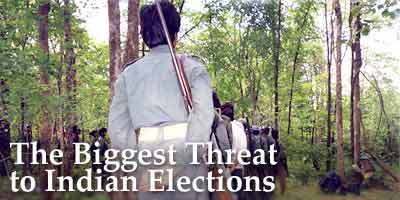Home > News > Elections 2004 > Special
The Rediff Election Special/Josy Joseph in New Delhi
April 02, 2004

The biggest threat to the general election does not come from terrorists in Jammu and Kashmir and the northeast with their Kalashnikovs and rocket-launchers.
It is the spectre of Maoist violence that is worrying security agencies.
Thousands of central and state security personnel will be stretched to their limit during the election as they fight a cat and mouse game with men and women who still swear by the dream of proletariat rule.
According to a Union home ministry assessment, Maoist or Naxalite violence is of serious concern in 12 of India's biggest states.
"A massive geographical spread is a nightmare for any security agency," says a Border Security Force officer.
Who are the Naxalites? A Primer
The Election Commission has already held consultations with the security agencies, state directors general of police, chief secretaries and other officials.
The home ministry assessment, a copy of which is with rediff.com, paints a dismal picture.
 The threat is spread across the 'Compact Revolutionary Zone,' which stretches from the Nepal border to Tamil Nadu.
The threat is spread across the 'Compact Revolutionary Zone,' which stretches from the Nepal border to Tamil Nadu.
Fifty-three districts have been identified as 'highly affected' by the threat of violences by the Naxalites, while 17 are 'moderately affected.' Fifty-two districts are 'less affected' and 21 are possible targets.
"That is only an official assessment. The Naxalites are capable of moving further away from these and targeting new locations," the officer says.
Three groups basically drive Maoist extremism: The Communist Party of India (Marxist-Leninist) [People's War], Maoist Communist Centre of India and the Communist Party of India (M-L) Liberation.
The PW is the most deadly of the three.
The CPI (M-L) Liberation is also into violent methods, but is not very widespread.
Last year Naxalites accounted for nearly 88 percent of organised violence and killings in the country.
"It is not well understood even by security agencies that Naxal violence remains the biggest threat to internal security right now," argues a North Block official.
In 2003, there were 1,671 Naxalite attacks, in which 95 security personnel and 422 civilians were killed. In the same period 250 extremists were also killed.
Almost 3,000 extremists surrendered or were arrested in 2003.
However, the "surge and spread of Maoists and Naxals is steadily growing," adds another home ministry official.
The PW operates in Andhra Pradesh, Maharashtra, Chhattisgarh, Orissa, Jharkhand and Bihar. Last year it was responsible for over 65 percent of extremist violence in India.
Among its high-profile attacks was the one on Andhra Pradesh Chief Minister N Chandrababu Naidu last October near Tirupati.
The MCC is very active in Bihar and Jharkhand and has a presence in Chhattisgarh, Uttar Pradesh, West Bengal and Orissa.
The targets are the same: police stations, police informers, government machinery, landlords and moneylenders, etc.
"Election as an entire process is a target. We have a tough challenge on our hands," says the BSF officer.
"Their extensive network in remote villages, spread over forests and hills, are all key strengths of Left-wing groups. It is impossible for any security agency to guarantee full containment of them during such a broad exercise," he adds.
In Andhra Pradesh 18 districts, covering almost an equal number of Lok Sabha constituencies, have been identified as highly affected by PW operations.
In Telangana, Rayalaseema and South Coastal Andhra, several new guerrilla squads have been set up.
"Andhra is our biggest challenge. The worst part is that in several parts of the state there is active support for the PW cadres," says the officer.
The police are trying to carry out aerial reconnaissance of PW-infested areas.
In Bihar, the MCC and PW are a menace across Jehanabad, Patna, Aurangabad, Arwal, Rohtas, Jamui, Gaya, Kaimur, Nawada and Darbanga districts. Extremism is taking root in East and West Champaran districts and Begusarai.
Jharkhand and Chhattisgarh also remain major problem areas for the central agencies, who have been ordered by the Election Commission to provide adequate forces to all the affected states.
Orissa witnessed 59 incidents in which 10 security personnel, four civilians and two Naxalites were killed.
In Maharashtra 88 Naxalite attacks were reported. Seven security personnel, 24 civilians and 11 Naxalites were killed in these attacks. What is noticeable, according to an official in the central government dealing with Naxalite issues, is the continuing trend of attacks on 'class enemies' in areas such as Gadchiroli, Chandrapur and Gondia.
The Naxalite menace is also visible in UP, Madhya Pradesh, West Bengal and Kerala. "Though security forces have been able to inflict large-scale damage on the Naxal groups, there is no indication of their level of activity declining. In relative terms Naxal attacks in states like Kerala have gone up three times," says the home ministry official. In the early seventies, Bengal and Kerala were most affected by Naxalite violence, until State repression crushed the life of the Maoist movvement in these two states.
EXTERNAL LINKS: Please note, rediff.com is not responsible for the content of these external links nor does rediff.com or its staff endorse the content of such links. These are only being provided as a source of reference
History of the Naxalite movement
Naxalbari Movement - The fire that was
'They are called Naxalites'
Communist Party of India (Marxist-Leninist)